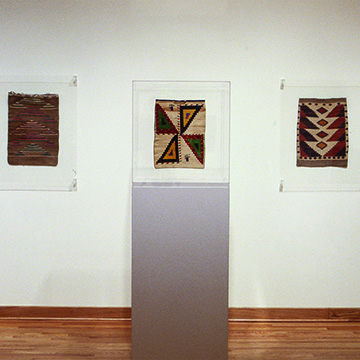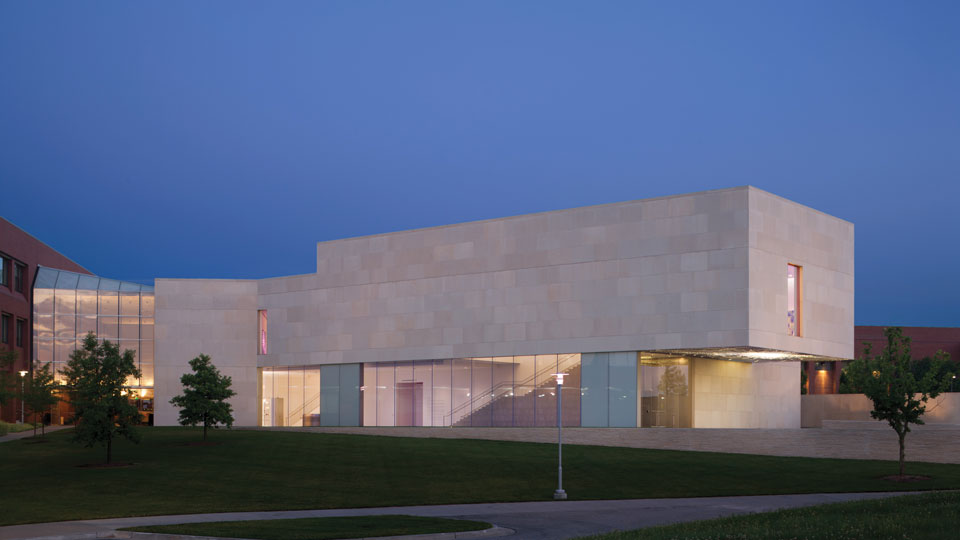The Plateau Bag
A Tradition in Native American Weaving
With this comprehensive exhibition of Plateau bags, the JCCC Gallery of Art continues its commitment to the presentation of American Indian art. Characterized by striking and imaginative designs, Plateau bags are among the most outstanding creations of American Indian weavers. Plateau bags, commonly called Nez Perce or cornhusk bags, were one of the primary forms of artistic expression for American Indian women in the Plateau region of the United States, which is bounded on the east and west by the Rocky and Cascades mountains. These woven bags were integral to the lives of these nomadic peoples, which included the Nez Perce, Umatillo, Walla Walla, and Yakima groups, who used them to gather seasonal foods, berries and roots as they moved throughout the area.
The artist created the flat, double-sided bags without the aid of a loom, working row by row, continually turning the bag while inventing two completely different designs on each side. Generally, one side of the bag displays a more complex design and the other presents a repetitive banding of geometric shapes. The weaver imagined highly inventive and complex designs, and without the aid of a drawn pattern, completed the seamless bags made from hemp and other indigenous materials. Besides using plants in their natural shades of brown or beige, the weaver dyed plant fibers with minerals and herbs to obtain the bright, rich colors used in the designs.
The Plateau peoples used twined bags to carry and store their winter survival items. In addition, the bags served as important trade items and as an integral part of the ritualized marriage ceremony in which the groom’s and bride’s families exchanged hemp bags filled with roots and berries to validate the marriage ceremony. In the early eighteenth century, horses were introduced to the Plateau region and twined bags took on an additional function – that of the “saddle bag.” In 1805 – 1806, Lewis and Clark travelled through the Plateau region and unsuccessfully attempted to trade for the bags with the Nez Perce tribe. This incident, reported by Lewis and Clark, may provide the reason that these bags are often known as “Nez Perce.”
Contact with white settlers and the introduction of corn changed the basic hemp structure of the bags, as weavers found cornhusk fibers to be more flexible than native plants in the creation of the bags. The bags often took on the interchangeable name of “cornhusk bag.” The Plateau underwent yet another significant change between 1890 and 1910, when the Arts and Crafts movement arose. Americans’ desire for handcrafted items led to an interest in the handwoven bags of American Indian artists. Weavers adapted traditional designs and forms to explore new avenues of artistic expression. Artists abandoned the use of natural dyes, using tradecloth and brightly colored yarn for accents. Eventually, weavers used easily purchased wool yarn to create the entire design on a cornhusk background. To retain traditional features, some weavers used hemp at the top and bottom of their bags.
This exhibition features over sixty handwoven bags by American Indian artists, and a number of the bags were created before 1900. The change in materials and designs used by the weavers can be detected in the bags on display. Works range from bags created entirely from hemp to more recent bags using cornhusk and yarn. Designs include large complex motifs, geometric patterns arranged diagonally or horizontally and more “westernized” images ranging from butterfly motifs to images derived from Oriental rugs. Each bag exhibits expertize of the artist in weaving the colorful designs of these once utilitarian objects now highly regarded as outstanding examples of textile art.
A lecture by Lynette Miller, curator of the Wheelwright Museum, Santa Fe, New Mexico, will be presented at the opening reception. A comprehensive catalogue of the exhibition with an essay by its co-curator Natalie Linn will be available for purchase.
We are deeply indebted to Carol and Lewis Berey, Bruce Boys, Continental Insurance Company, Michael Engl, Darlene Frederick, Kate and Joel Kopp, Natalie Linn, Lois and Lee Minor, Steven Pickelner, Dina Schnitzer, and Fifi White for making this exhibition and publication possible. Their willingness to share their collections, knowledge, and resources was gratifying and inspiring.






